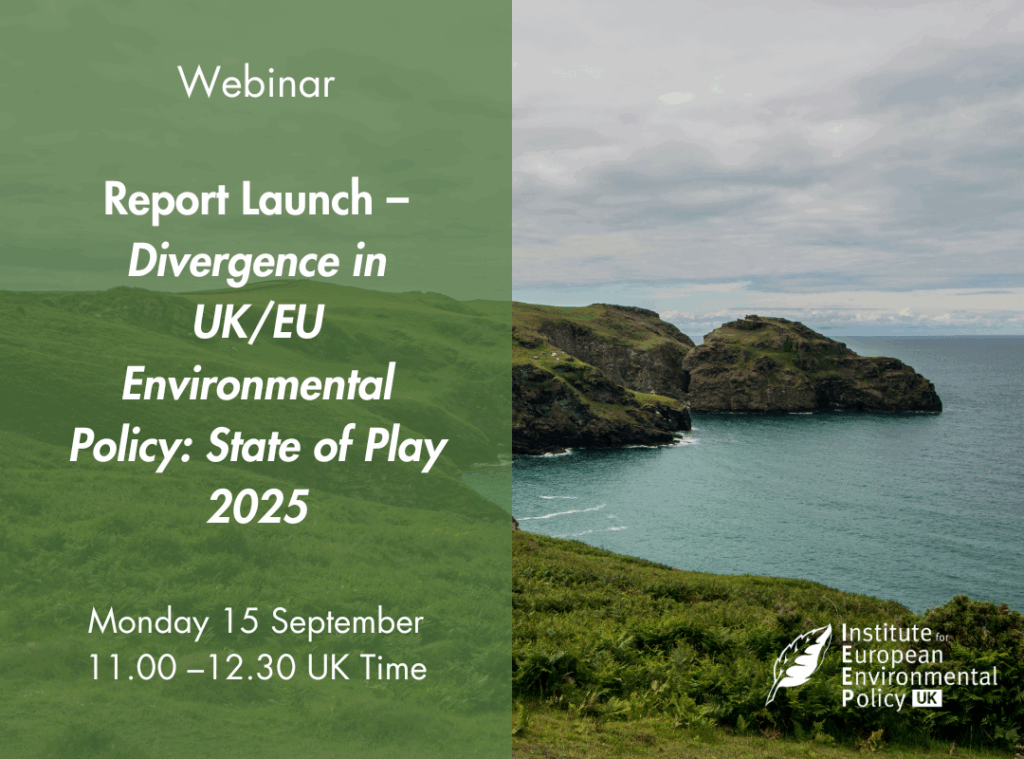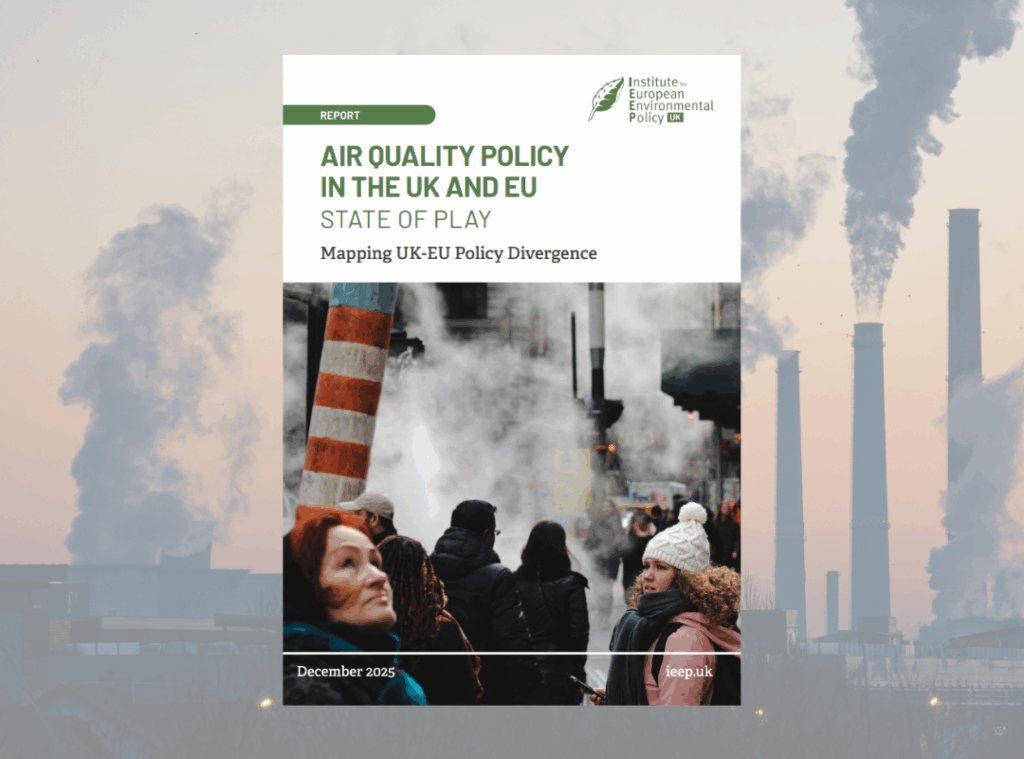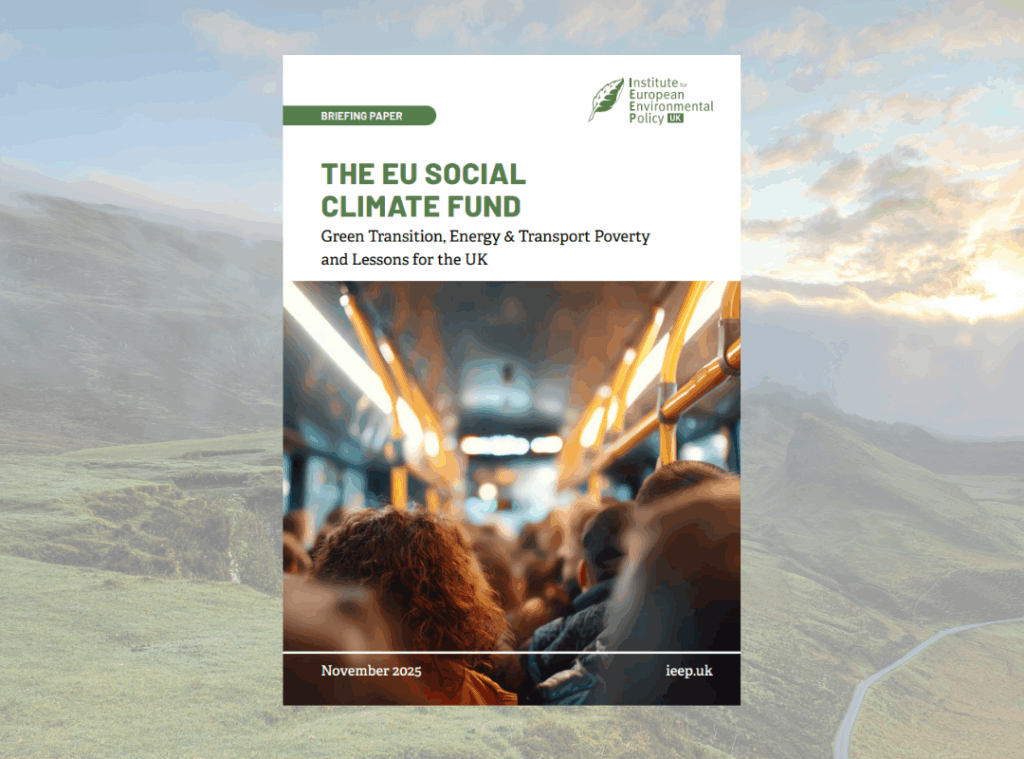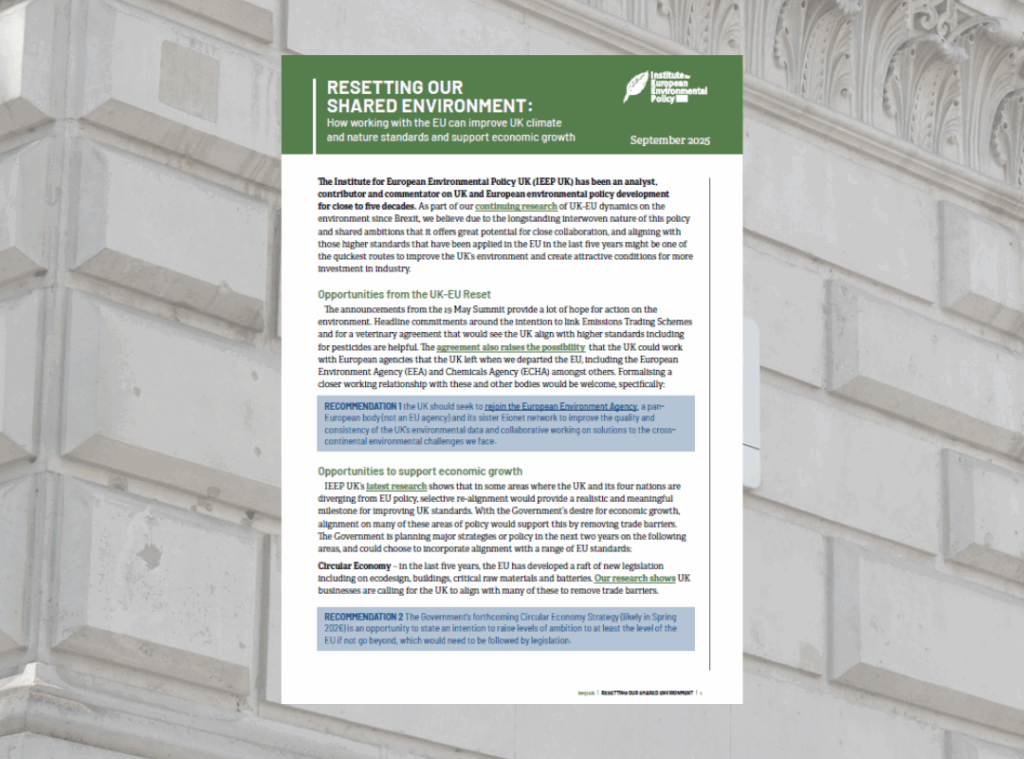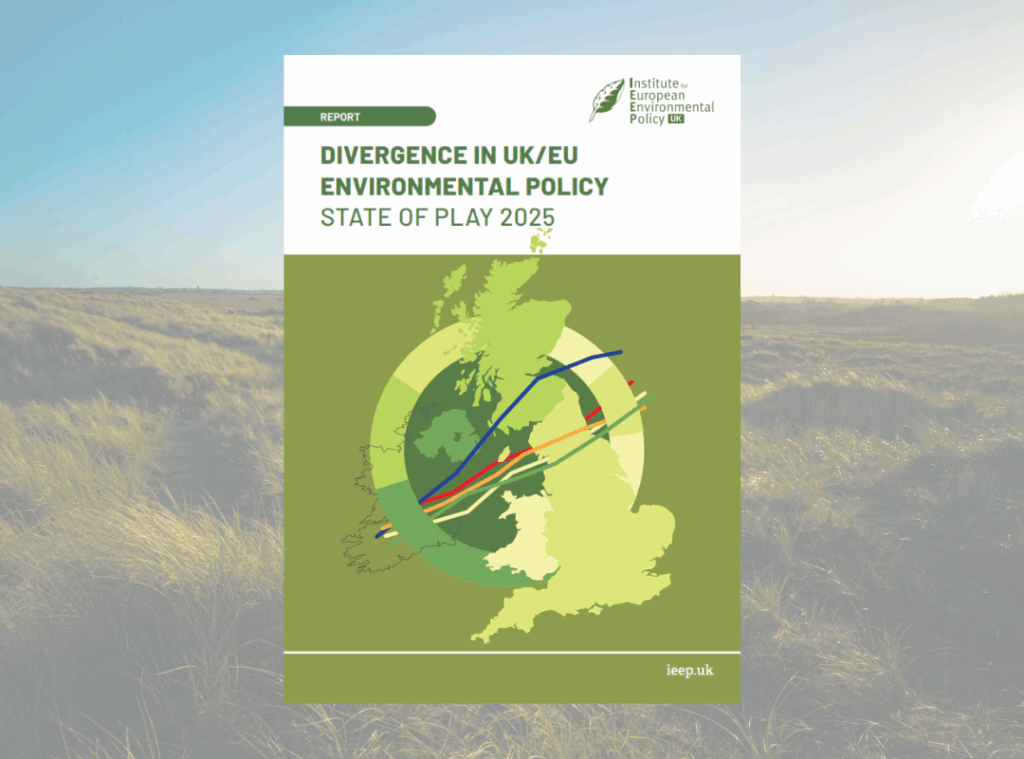Divergence in UK/EU environment policy
IEEP’s definitive guide to European environmental policy
European policy in the form of EU directives, legislation, strategic plans and other measures has grown to be perhaps the most comprehensive body of environmental law in the world, with an influence extending well beyond Europe. It is the bedrock of most areas of national environmental law in EU countries. Combining a mixture of both long-term targets and very specific commitments it is currently in the spotlight within a debate on the future role of EU policy and the right balance to be struck between European and national measures.
After many years of being a purchasable publication, the Manual is now downloadable for free from IEEP’s website. The Manual of European Environmental Policy, provides a comprehensive account of EU environmental policy and its development up until 2012, when publication ceased. It includes every item of ‘dedicated’ EU environmental legislation and a description of how environmental policy has been integrated into other EU policies such as agriculture, transport and energy. The complexities, changes and developments of EU environmental policy up to 2012 are catalogued, together with the changing drivers behind EU environmental policy over the decades.
At time of release the Manual was the most systematic, comprehensive and reliable source of information on EU environmental policy and it continues to be an essential research tool for anyone working, studying or researching in this field. The publication is divided into chapters, reflecting the key aspects of environmental policy such as air quality, biodiversity, resource use and climate change. Each chapter contains a general overview of the policy area, followed by details of individual Directives, Decisions and Regulations, as well as references to key EU documents and related legislation.
Explore the Manual of European Environmental Policy
This publication forms a section of the Manual of European Environmental Policy, published by IEEP in 2012. All items mentioned in the manual are listed in the index, followed by the section on ‘Proposed Policy’ and ‘Anticipated Policy.
Download here:
1.1 An introduction to EU environmental policy
1.2 The EU institutions
1.3 The EU agencies
1.4 EU decision making process
1.5 Environment in the treaties
1.6 The sixth EAP and the thematic strategies
1.7 The SDS Lisbon strategy and the Europe 2020 strategy
1.8 Environmental policy integration
1.9 Environmental policy instruments
1.10 Approaches to pollution control
1.11 Implementation and enforcement
1.12 International conventions
1.13 Networking to support implementation
This is a chapter of IEEP’s Manual of European Environmental Policy. This chapter focuses on EU air quality policy. The policy field is extensive and contains many directives that impose standards, provisions and developments of air quality management and regulation.
Download here:
2.1 Overview of EU Air Policy
2.2 Air quality framework
2.3 National emission ceilings
2.4 Emissions from vehicles
2.5 Volatile organic compounds from petrol
2.6 Quality of petrol and diesel
2.7 Sulphur content of certain liquid fuels
2.8 Emissions and noise from pleasure boats
2.9 Related legislation air quality
2.10 International Conventions and Cooperation – air quality
2.11 Historical legislation – lead in petrol
2.12 Historical legislation – nitrogen dioxide
2.13 Historical legislation – ozone
2.14 Historical legislation – smoke and sulphur dioxide
2.15 Historical legislation – exchange of information
2.16 Historical legislation – lead
This publication forms a section of the Manual of European Environmental Policy, published by IEEP in 2012. This chapter on EU climate change policy outlines the initial EU programme to stabilise CO2 emissions in the EU with explanations of the directives, decisions and legislation that were employed to improve energy efficiency and reduce emissions. Topics discussed in this chapter include: energy taxation, promotion of electricity from renewable sources, and carbon capture and storage. Further sections cover legislation on standardising, trading, monitoring and limiting emissions.
Download here:
3.1 Overview of climate change
3.2 Effort sharing to reduce greenhouse gas emissions
3.3 Emission trading
3.4 Monitoring and limiting greenhouse gases
3.5 CO2 from passenger cars
3.6 Emission performance standards for light commercial vehicles
3.7 Energy taxation
3.8 Fluorinated greenhouse gases
3.9 Promotion of electricity from renewable sources
3.10 Promotion of the use of biofuels or other renewable fuels for transport
3.11 Promotion of the use of energy from renewable sources
3.12 Combined heat and power
3.13 Use of carbon capture and storage
3.14 Energy end-use efficiency and energy services
3.15 Energy performance of buildings
3.16 Energy using products
3.17 Energy labelling
3.18 Intelligent Energy Europe
3.19 Adapting to climate change
3.20 Related legislation – climate change
3.21 International convention and cooperation on climate change
This publication forms a section of the Manual of European Environmental Policy, published by IEEP in 2012. This chapter provides information on EU industrial pollution policy, which outlines and discusses the legislation in place to minimise the negative effects of harmful substances and pollutants on the environment and human health. Topics include: industrial emissions; Integrated Pollution Prevention and Control (IPPC); major accident hazards and waste incineration.
Download here:
4.1 Overview of EU policy on industrial pollution
4.2 Industrial emissions
4.3 Integrated pollution prevention and control
4.4 Major accident hazards
4.5 Large combustion plants
4.6 Waste incineration
4.7 Titanium dioxide
4.8 Volatile organic compounds from industry
4.9 Eco-management and audit scheme
4.10 European pollutant release and transfer
4.11 Related legislation on industrial pollution
4.12 International Conventions on industrial pollution
4.13 Historical emissions from industrial plants
4.14 Historical municipal waste incineration
4.15 Historical hazardous waste incineration
This publication forms a section of the Manual of European Environmental Policy, published by IEEP in 2012. In this chapter the development of EU water pollution policy is explored. There are now numerous directives, regulations and decisions that are employed to secure, protect, and manage freshwater and marine environments and control water pollution. For example this chapter includes the Water Framework Directive and Marine Strategy Framework Directive and other directives and policies covering flooding; water scarcity; and dangerous substances in water.
Download here:
5.1 Overview of EU policy on water and marine
5.2 Water framework directive
5.3 Marine strategy framework directive
5.4 Groundwater
5.5 Quality standards for water
5.6 Urban wastewater treatment
5.7 Nitrates from agricultural sources
5.8 Detergents
5.9 Bathing water
5.10 Drinking water
5.11 Floods
5.12 Water scarcity and droughts
5.13 Oil pollution at sea
5.14 Dangerous substances in water
5.15 Shellfish waters
5.16 The freshwater fish fishline directive
5.17 The European Union water initiative
5.18 Related legislation on water and marine
5.19 International conventions and cooperation on water
5.20 International conventions and cooperation on marine
5.21 Historical legislation – surface water for drinking
5.22 Historical legislation – water exchange of information
This publication forms a section of the Manual of European Environmental Policy, published by IEEP in 2012. This chapter on EU waste policies focuses on the management of waste, the environmental requirements with which waste management installations must comply and the big picture policy initiatives focused on waste. Some of the topics include: reducing waste production; limiting the contaminants entering waste streams; reducing the levels of disposal waste and increasing levels of products reused, recycled and recovered.
The Manual also includes another chapter relevant to reducing the environmental footprint of waste: Chapter 7 – Resources. Here there is also a focus on resource use and product policy, detailing the key measures aimed at preventing waste generation and reducing the use of hazardous materials in products.
Download here:
6.1 Overview of waste policy
6.2 Waste framework directive
6.3 Waste shipment
6.4 Hazardous waste
6.5 Landfill
6.6 Waste statistics
6.7 Mining waste
6.8 Ship generated waste
6.9 Disposal of waste oils
6.10 Disposal of sewage sludge
6.11 Disposal of polychlorinated biphenyls
6.12 Related legislation – waste
6.13 International convention and cooperation – waste
This publication forms a section of the Manual of European Environmental Policy, published by IEEP in 2012. This publication forms a section of the Manual of European Environmental Policy, published by IEEP in 2012. This chapter illustrates the variety of laws, policies and guidance documents that have been adopted by the European Commission, Parliament and Council to improve the efficiency of our use of natural resources, and to reduce environmental impacts throughout a product’s life cycle.
There is a focus on resource management to push the EU to a more sustainable pattern of consumption, which is illustrated through measures to improve the environmental performance of vehicles, batteries and electrical equipment, as well as sustainable production, management and packaging of products.
Download here:
7.1 Resource use overview
7.2 Integrated product policy
7.3 Sustainable consumption and production and sustainable industrial policy SCP SIP action plan
7.4 Ecolabelling
7.5 Packaging and packaging waste
7.6 Batteries
7.7 End of life vehicles
7.8 Waste electrical and electronic equipment WEEE
7.9 RoHS
7.10 Related legislation – resource use
7.11 International conventions and cooperation – resource use
This publication forms a section of the Manual of European Environmental Policy, published by IEEP in 2012. This chapter on chemicals focuses on the two main strands of EU chemicals policy: REACH – (Registration, evaluation, authorisation of restricted chemicals) and CLP – (classification, labelling and packaging). The chapter also covers the different legislation that aims to reduce the negative impact of chemicals to the environment and humans, while maintaining a functioning internal market. The sections discuss the authorisation, transportation, standardisation, and sustainable use of dangerous goods, chemicals and substances.
Download here:
8.1 Overview of EU policy chemicals
8.2 Registration, evaluation, authorisation and restriction of chemicals – REACH
8.3 Classification, labelling and packaging of chemical substances and mixtures
8.4 Inland transport of dangerous goods
8.5 Maritime transport of dangerous goods
8.6 Export and import of dangerous chemicals
8.7 Asbestos
8.8 Substances depleting the ozone layer
8.9 Authorisation and marketing of plant protection products
8.10 Maximum residue level of pesticides
8.11 Sustainable use of pesticides
8.12 Authorisation and marketing of biocides
8.13 Safety standards on radiation
8.14 Shipment of radioactive substances and waste
8.15 Emergency food protection
8.16 Related legislation – chemicals
8.17 International conventions and cooperation – chemicals, hazardous substances and pesticides
8.18 International conventions and cooperation – chemicals radioactivity
8.19 Historical legislation – restrictions on marketing and use of certain dangerous substances and preparations
8.20 Historical legislation – testing existing chemicals
8.21 Historical legislation – screening for lead
This publication forms a section of the Manual of European Environmental Policy, published by IEEP in 2012. In this chapter the development of the EU biodiversity policy framework is explored. It presents the legislation that has been introduced to satisfy the growing need for biodiversity conservation, including the purpose and development of the Birds Directive, Habitats Directive and the Habitats and Species Conservation Directive. Furthermore the legislation on Genetically Modified Organisms (GMOs) is discussed including the regulation of their contained use, deliberate release, use in food and feed, traceability and labelling, and transboundary movements.
Download here:
9.1 Overview of EU policy Biodiversity
9.2 Birds and their habitats
9.3 Habitats and species conservation
9.4 Trade in Endangered Species
9.5 Genetically modified organisms – contained use
9.6 GMOs Deliberate Release
9.7 GMOs Food and Feed Update
9.8 Genetically modified organisms – traceability and labelling
9.9 GMOs transboundary movements
9.10 Biodiversity related legislation
9.11 Biodiversity – international conventions and cooperation
9.12 Historical legislation – whales
This publication forms a section of the Manual of European Environmental Policy, published by IEEP in 2012. This chapter contains various pieces of EU policy which regulate noise pollution.The directives in this chapter generally have two purposes: to ensure that noise limits for products do not create barriers to trade; and progressively to reduce noise limits from transport for environmental reasons.
Individual directives covered include: ambient noise, public transport vehicles; motorbikes; aeroplanes and tractors. Further legislation is discussed includes: the Household Appliances Directive and the Noise in the Work Place Directive.
Download here:
10.1 Overview of EU policy Noise
10.2 Assessment and management of noise
10.3 Cars buses lorries and trains
10.4 Motorcycles
10.5 Tractors
10.6 Aircraft
10.7 Outdoor Equipment
10.8 Noise in the workplace
10.9 Household appliances
10.10 Related legislation – noise
10.11 Historic Legislation noise outdoor equipment
This publication forms a section of the Manual of European Environmental Policy, published by IEEP in 2012. This chapter provides a detailed analysis of a number of existing measures currently in place that span all EU environmental policy areas. These measures are aimed at integrating policy tools and are used in assessing the impact of particular projects and activities on the environment. The chapter also reviews measures aimed at promoting environmental rights through involving the public and civil society organizations in formulating and implementing responses to the environmental challenges faced by the EU.
Download here:
11.1 Overview of EU policy – supporting policy
11.2 Environmental impact assessment
11.3 Strategic environmental assessment
11.4 Environmental crime
11.5 Public participation
11.6 Access to information
11.7 Environmental liability
11.8 Access to Community institutions and bodies
11.9 Environmental inspections
11.10 Historical legislation – information on the state of the environment CORINE
11.11 Historical legislation – environmental statistics
This is a chapter of IEEP’s Manual of European Environmental Policy. This chapter sets out the EU’s main funding instruments that have environmental implications, including the European Agriculture funds, the European Fisheries Fund and the Structural and Cohesion funds.
Download here:
12.1 Overview of EU policy Funding instruments
12.2 EU Structural and Cohesion Funds
12.3 LIFE
12.4 European Agricutural Fund for Rural Development
12.5 European Fisheries Fund
12.6 Civil protection from disasters
12.7 European Union Solidarity Fund
12.8 Seventh RTD FP
12.9 Competitiveness and Innovation FP
This publication forms a section of the Manual of European Environmental Policy, published by IEEP in 2012. This chapter sets out the development of some of the most important links between EU environmental policy and other policy areas, such as sustainable development, environmental policy integration and more recently, processes of European social and economic reform. This is done by examining the way environmental issues have been linked to specific policy areas:
- Agriculture: Agriculture and land management play an important role in maintaining and improving the environmental condition of the farmed landscape, including farmland biodiversity, landscape character, water quality, levels of greenhouse gas emissions, capacity for carbon storage, etc. The Common Agricultural Policy plays a role in promoting both basic and more enhanced forms of environmental management.
- Land degradation and protection: Soil or land degradation and protection and spatial planning, are the two fields central to EU law making to ensure land utility and function, Land is a vital resource enabling the production of food, the preservation of biodiversity, facilitating the natural management of water systems and acting as a carbon store.
- Forestry: Common policies directly or indirectly affect forestry and forests, such as the Common Agriculture Policy, the Cohesion Policy as well as environmental legislation on nature protection, air quality and climate change. The EU contributes to supporting forest policy particularly regarding the implementation of sustainable forest management and the support of national forest programmes.
- Fisheries: Fishing remains one of the most significant factors influencing the state of the European marine environment. The Common Fisheries Policy aims to ensure a sustainable and responsible management of fisheries which is crucial as there are concerns in many parts of Europe for the state of fish stocks, levels of by-catch and marine habitat destruction.
- Maritime Policy: The EU Integrated Maritime Policy aims to provide a joined-up policy framework for the development of EU policies affecting maritime areas. It covers all policy areas and stresses the Marine Strategy Framework Directive as its ‘environmental pillar’. Subsequent policy documents directly on the substantive issues of the policy as well as on sectoral policies and regional policies have followed.
- Energy: The production and use of energy is a major source of environmental problems, with combustion of fossil fuels contributing to greenhouse gas emissions, acidification and waste. A number of general initiatives have been developed to reduce the impacts of energy use, such as an overall framework for energy policy. Energy is connected to other sectors of policy such as climate change as policy initiatives have been launched by the EU Commission, specifically linked to the Kyoto Protocol under the UN Framework Convention on Climate Change.
- Transport: The construction, maintenance and presence of infrastructure, the manufacture and disposal of vehicles and emissions from the transport sector are just some of the contributions to poor air quality, ozone depletion, acidification and global climate change. These environmental issues have become increasing embedded in Transport Policy with a focus on reducing emissions, which overlaps with two other policy areas: air quality and climate change.
- Trade: Removing barriers to trade, completing the internal market and fostering conditions to encourage economic growth are amongst the key objectives of the EU. Some internal market measures are directly relevant to environmental policy, while economic growth and trade also have indirect environmental effects, for example through increased freight movements, emissions, and the use of natural resources.
- International development: EU Member States and the European Commission are both major donors of development aid. While developing countries are responsible for identifying and responding to environmental issues affecting them, EU development policy can support such efforts, and the provision of appropriate development aid and improving the level of coherence between different EU external policies can provide a valuable contribution in this area.
Download here:
13.1 Sectoral Policies key to the Environment
13.2 Agriculture
13.3 Land degradation and protection
13.4 Forestry
13.5 Fisheries
13.6 Maritime policy
13.7 Energy
13.8 Transport
13.9 Trade
13.10 International development
This publication forms a section of the Manual of European Environmental Policy, published by IEEP in 2012. All items mentioned in the manual are listed in the index, followed by the section on ‘Proposed Policy’ and ‘Anticipated Policy.
Download here:




